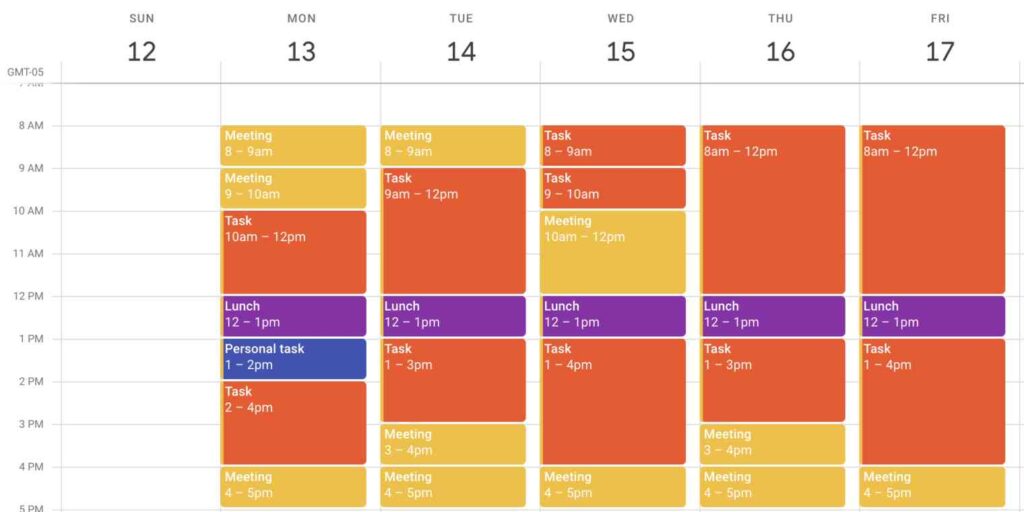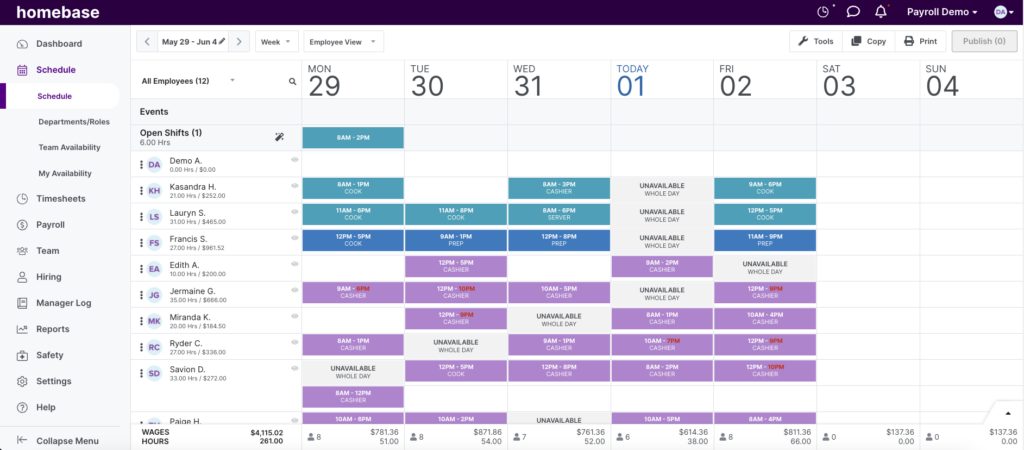
Remember in school when you looked at your homework and thought:
I’ll start studying at 3pm
Ok, at 3:15pm
I’ll definitely start at 3:30pm?
Or maybe you’ve felt daunted by the prospect of a 30-minute workout? Only you never got around to starting your homework, and you never did that workout, and now you have a pile of tasks you don’t know when you’ll ever finish.
Losing track of time when it comes to homework or exercising, while frustrating, doesn’t carry the same weight as trying to effectively run a small business when tasks are piling up and you just can’t seem to find the time to manage them all. That’s where time management comes in.
In this article, we’ll go through some of the most popular time management techniques that work great for small businesses. There are plenty to choose from, so we’ve condensed them down to what we consider the most effective.
What are time management skills?
Put simply, time management skills are someone’s capability to plan and organize their time and get a series of tasks done. In a small business context, they mean owners and managers are able to get through their daily to-do lists and have enough time to drive the business forward without burning out or working unreasonable hours. They also mean that team members complete all their essential tasks and keep everything running smoothly without worrying about overtime or overwork.
Generally speaking, time management skills help people work more efficiently, make better decisions, and achieve their goals faster and with less stress. There are nearly limitless ways to improve your time management skills, including an array of popular strategies like Pomodoro, time boxing, and time blocking.
Small business owners often also find it helpful to use team management software to automate time-consuming administrative tasks like scheduling and time tracking. That way, they can free up hours of their working days and spend more time on other higher-priority work.
5 useful time management techniques for small businesses
Maximizing productivity and profitability is crucial for any small business to stay afloat. These five time management techniques are uniquely suited to business owners who find themselves struggling to find balance when it comes to managing their workload.
1. Pomodoro
The Pomodoro technique breaks your workday down into timed slots, which helps you work as efficiently as possible and takes away the scary prospect of having to concentrate for several hours straight. The technique was developed by an Italian student who felt overwhelmed by all his studies and decided to make his life easier by working in timed increments.
Here’s how it works:
Pick a task
Set a timer for 25 minutes
Focus on that task until the timer buzzes
Once the time is up, take a short break and do something unrelated to work
Once your break is over, set another time and work for another 25 minutes
Repeat this cycle until your task is done
Sounds pretty easy, right? If you find that 25 minutes is too long or too short, you can adjust the Pomodoro approach to suit your style. However, be wary of working for too long and past when you’re at your most productive. Give yourself enough time to focus, but not so much that you burn out.
2. “Getting things done”
Getting Things Done (GTD) is a five-step technique that encourages people to gather all their thoughts and put them down on paper. The aim of this exercise is to clear your mind and empower you to face your work with a fresh outlook.
Let’s take a look at how it works in more detail:
Capture: Spend some time noting down every task that comes to mind on paper or digitally.
Clarify: When you’ve written everything down, go through the list and clarify exactly what everything means. Is it an actionable task, a longer project, or just information? Decide where you need to take action and what can be put on hold.
Organize: Give each task a label or category, for example, personal, work, or projects.
Reflect: Review your lists at the start of each day and ask yourself what’s next. Also, think about whether you need to get it done today or tomorrow. This will keep you on top of your priorities and working as efficiently as possible.
Engage: Now that you have everything written down and organized, all that’s left to do is start working on each task.
GTD is a flexible time management technique that is ideal for small business owners who often battle with the seemingly impossible task of remembering everything they have to do. It helps to get all the clutter out of your head and onto paper (or a screen) — you’ll start clearing your to-do list in no time.
3. Time blocking
Time blocking is a simple time management technique that quite literally involves blocking chunks of time in a calendar. You can assign as much or as little time as you like to each task in your workday, but you have to stick to that block. Once you’ve reached the end of that block of time, you can move on to the next task.
Adding a bright color to each block of time can cheer things up a bit and add a splash of fun to organizing your time. Blocks can range from five minutes to several hours, but be realistic about how much time you can spend on each task. In addition, take a short break after each task to unwind and prepare for the next one on your list.

It might seem too simple to be true, but this technique allows you to focus all your resources on one task at a time rather than spreading yourself too thin. Small business owners and managers often find themselves easily distracted by small tasks and wind up jumping between things, never fully completing their work. All in all, running a business requires huge mental effort, and time blocking could be exactly the technique that allows you to cram an 80+ hour work week into more manageable chunks.
4. Timeboxing
Timeboxing and time blocking sound so similar that we wouldn’t blame you for mistaking them for the same thing. Time blocking gives you some flexibility to adjust each block if needed, while time boxing requires you to stick to a strict schedule. You must complete each task within the time limit you’ve set. Strict deadlines are often highly motivating for procrastinators. When a deadline looms large, you have no choice but to get the job done. For small business owners, the margins are always thin, and effectively managing your own time as well as your team’s time is crucial to ensuring that your business runs as smoothly as possible. Blocking out time for your team to complete their work adds an element of urgency that might be just what they need to get their work done.
For effective timeboxing, estimate the time each task will take you, choose the length of time for your time boxes, and put them into your calendar. Then, set a timer and get to work on that task while keeping an eye on how much time you have left. If you run out of time before you finish, that’s an opportunity to reevaluate your time estimates.
It’s tempting to keep working beyond the limits of your timebox, but that defeats the purpose, and you’ll only end up procrastinating even more. Respect the timer and work towards your goal. You’ll have your to-do list ticked off in no time!
5. Plan around your productivity
Most of us have a time of day when we work most productively. Are you a morning person or a night owl? Perhaps the idea of working on your biggest tasks first thing is nausea-inducing. Use that to your advantage! If you already know that you work hardest after lunch, then plan your day around that. The same goes for those who prefer to rise with the sun and get all the hard work done by 12pm.
For example, let’s say you’re a cafe owner who gets up early but can’t face the prospect of doing your payroll when you first arrive in the morning. Plan to do this task after the first shift has ended. You can even get ahead of the curve by letting your team know what day and when you’ll be processing payroll through Homebase’s team chat app. Keep your team up-to-date and motivated with a quick message about your priorities for each day.
This technique is by far the most flexible, as it allows you to choose when and how hard you work. You can even incorporate all of the time management techniques previously mentioned in our list to be even more efficient.
How Homebase can level up your time management


We built Homebase to make it easier for owners and managers to run their small businesses. A big part of that is helping them better manage their time and ensure they can get everything done.
With Homebase, small business owners and managers can speed up and automate a lot of the administrative tasks that eat up big chunks of their workweeks. Use Homebase scheduling to create team member timetables based on people’s availability in a matter of minutes. Combine Homebase time tracking and payroll to drastically reduce the hours you have to spend checking timesheets and calculating paychecks every month. Meanwhile, you can stay in touch with your whole team with the team communication app, whether you’re in your office or out and about.
If you’ve got a small business-friendly platform like Homebase on your side, along with the time management techniques we mentioned in this article, you’ll never struggle through your to-do list again.







